















|
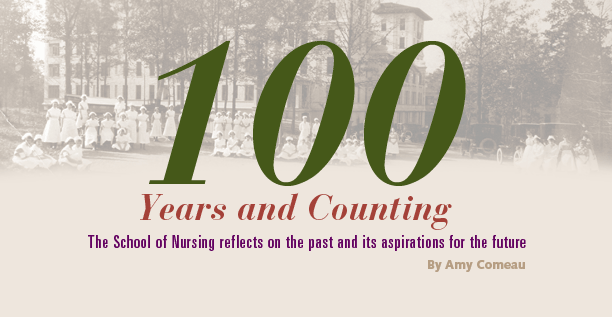 |
 |
  |
 |
 s
the Nell Hodgson Woodruff School of Nursing celebrates its Centennial
this year, it’s only fitting to contemplate the past and the
future. s
the Nell Hodgson Woodruff School of Nursing celebrates its Centennial
this year, it’s only fitting to contemplate the past and the
future.
Over the past century, the school
has evolved from a small training school in a 50-bed hospital to
a school that now graduates more than 200 baccalaureate, master’s,
and doctoral students each year. Emory is ranked among the top 10
private US schools of nursing, with the goal of becoming the best
private nursing school in the nation.
The evolution of the School of Nursing
since 1905 features seven moves, three new buildings, nine directors
of nursing, nine deans (some interim), and four name changes. The
school helped break the gender barrier by introducing more women
to a traditionally male campus and the color barrier by graduating
Emory’s first African American students.
When the school celebrated the groundbreaking
of the Asbury Circle building (its second building and sixth home)
in 1968, Dean Ada Fort reflected on the school’s first 60
years. The first 20 years marked the birth of the school on August
16, 1905, at the Wesley Memorial Hospital Training School for Nurses,
located at the corner of Auburn Avenue and Courtland Street in Atlanta
(now the site of the Auburn Avenue Research Library of African American
Culture and History). The school was a part of the hospital, and
both were housed in a renovated mansion known as the Calico House.
Directed by Alberta Dozier, the nursing program comprised two years
of practical training and some theoretical classroom instruction.
The second 20-year period began in
1922 when the school and hospital moved to the Emory campus. In
1929, the school moved into its own building, the Florence Candler
Harris Home for Nurses (now known as Harris Hall, a coed undergraduate
residence hall). In 1932, the school experienced its first name
change to Emory University Hospital School of Nursing.
The third 20-year period that Fort
referenced included the school’s third name change to Emory
University School of Nursing, when the school separated from the
hospital and became an independent school of the university, led
by Dean Julia Miller, in 1944. During this period, the school established
its baccalaureate and graduate programs, Fort began her 25-year
tenure as dean, and the Alpha Epsilon Chapter of Sigma Theta Tau
International, the honorary society for nurses, was founded.
The school was just entering its fourth
20-year period at the time of its 1968 building groundbreaking,
shortly after the school was renamed for Nell Hodgson Woodruff,
the wife of Coca-Cola magnate and Emory philanthropist Robert Woodruff.
Although she left nursing school to marry Mr. Woodruff in 1912,
Nell remained committed to nursing throughout her life, primarily
through voluntary service to the American Red Cross and Emory. The
school built the Asbury Circle building and with the move created
a new BSN curriculum that focused on a specific nursing model to
include basic nursing concepts and processes combined with clinical
practice experience.
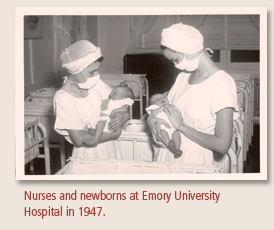

 t
the 1968 groundbreaking, Fort noted that throughout each period
of the school’s history, one constant remained: “A belief
that the only way a school of nursing can contribute toward producing
the greatest nurse is that it provide for the total development
of the person who is to be that great nurse.” t
the 1968 groundbreaking, Fort noted that throughout each period
of the school’s history, one constant remained: “A belief
that the only way a school of nursing can contribute toward producing
the greatest nurse is that it provide for the total development
of the person who is to be that great nurse.”
“This unchanging belief,”
she added, “has been the element which has made these 60 years
one progressive movement.” (Excerpted from
Emory Magazine, March-April 1968.)
After Fort retired, that “progressive
movement” continued under deans Edna Grexton, Clair Martin,
and Dyanne Affonso. Today, under Dean Marla Salmon, Emory is among
the nation’s top private schools of nursing.
In the past five years alone, the
school has risen eight notches in the US News & World Report
national rankings to 26th overall and 8th among private schools
of nursing, with its graduate nurse-midwifery program ranked 7th
nationwide. The school also has leapt to No. 18 in research funding
from the National Institutes
of Health. In the same time frame, the school graduated its first
PhD student; established the Lillian Carter Center for International
Nursing; began the federally funded Center for Research on Symptoms,
Symptom Interactions, and Health Outcomes; created the first simulation
training laboratory on campus; and hosted two global conferences
involving top government nurse and physician leaders from 70 countries.
“As we continue to be on the
upswing, our aspiration is not only to be great, but to be the best
in our commitment to care for others,” says Salmon. “What
sets our school apart from others is our commitment not only to
scholarship and leadership, but also to social responsibility.”
In this goal of “becoming the
best,” the emphasis is on what Emory University President
James Wagner calls “contributory” rather than “competitive
excellence.” As Wagner explains, “[We want] to practice
a meaningful excellence, a contributing excellence . . . [that]
advances whatever it touches. It changes the way other people think.
It changes the way other people do things.”
While the term “contributory
excellence” may be new, the concept of collaboration and leadership
toward the betterment of all is not new to the School of Nursing
or to the nursing profession. Inherent in being a nurse, especially
an Emory nurse, is the drive to do good through innovative care,
research, education, leadership, and service to vulnerable populations.
This concept of contributory excellence, of transforming the world
through care—of being a leader, a contributor, a collaborator—is
what will shape the School of Nursing and the nursing profession
in the century to come.
Amy
Comeau is director of communications for
the Nell Hodgson Woodruff School of Nursing. |
 |
 |
|
 |
1905

Wesley
Memorial Hospital and Training School for Nurses opened in Atlanta
on August 16 after being chartered a year earlier by the Methodist
Church. The 50-bed hospital and training school were located in
the Calico House, an antebellum mansion located at the corner of
Courtland Street and Auburn Avenue, just one block from Wesley Memorial
Church.
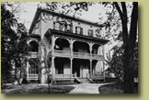


1907

The first class of 10 students (shown below with
staff) graduated from Wesley Memorial Hospital’s Training
School for Nurses. Bertha Eckhart, a transfer student from Washington,
DC, was the first graduate in 1906.
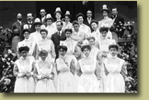


1908

Alberta
Dozier (later Williamson) became superintendent of the hospital
and director of the nursing school, serving in both roles until
1923. A member of the American Red Cross who was active in organizing
the Emory Unit in World War I, Dozier was a strong guiding force
in the early days of the nursing school.
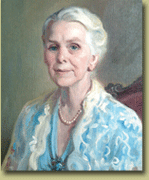


1912

Nell
Hodgson withdrew from nursing school in Athens, Georgia, to marry
Robert Woodruff, future leader of The Coca-Cola Company. The Woodruffs
became staunch supporters of Emory University. Nell Woodruff served
as a volunteer nurse with the American Red Cross during both world
wars, often working in the maternity ward.


1914

Dozier changed the two-year training program to
a three-year diploma program. Wesley Memorial Hospital Alumnae was
organized, serving as the grassroots level of the American Nurses
Association. Dozier insisted that all graduates become members of
the professional organization.


1922

Wesley Memorial Hospital and its Training
School for Nurses moved to a new hospital building on the Emory
campus. The hospital and nursing school were renamed Emory University
Hospital and Emory University Hospital School of Nursing in 1932.


1923

The
first class graduated from Wesley Memorial Hospital Training School
for Nurses on the Emory campus. During the 1920s, the US government
selected the school as one of only eight schools in the country
to lead in the development of university-based education in nursing.


1929

The Florence Candler Harris Home for Nurses
opened next to Emory University Hospital. Italian Renaissance in
design, the Harris nurses home included suites for nursing faculty,
offices, classrooms, laboratories, and living quarters for student
nurses, who had been living in the hospital. Harris was a longtime
volunteer with the Methodist Church, the hospital, and the nursing
school. She had three brothers, including Coca-Cola founder Asa
Candler, who donated the land and $1 million to establish Emory
University in 1915.
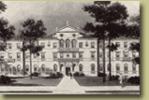
Timeline continued on Hearing
Their Voices
|
|
|
|











